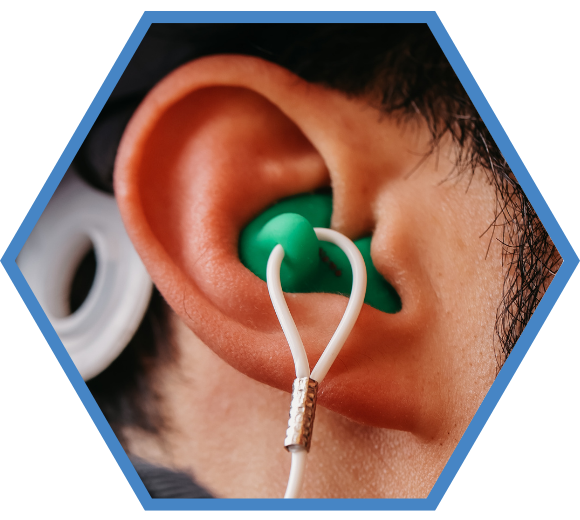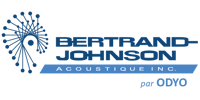CUSTOM EARPLUGS
Choosing hearing protection
Regulatory and practical aspects

By Hany Ghonaim | Founder at ODYO
Preventing noise-related hazards in the workplace is an important issue for Quebec companies. As stipulated in the Regulation respecting occupational health and safety (RROHS), when noise reduction measures at source or administrative measures cannot maintain a safe noise level, the use of personal hearing protectors becomes essential.
This article explores the selection criteria for hearing protectors according to the RSST, CSA Z94.2-14, CSA Z1007- 22 and practical aspects based on our expertise at Bertrand-Johnson Acoustics.
When should you use hearing protection?
Excessive noise in the workplace can lead to irreversible hearing loss, stress, and reduced concentration and quality of life. So it's always a good idea to use hearing protection when exposed to noise at work or during noisy leisure activities.
Section 141.1 of the RROHS stipulates that the hearing protectors provided must attenuate noise in such a way that the worker is not exposed to values exceeding those set out in section 131 of the RROHS, i.e. 85 dBA over 8 hours. Employers must ensure that the choice of protectors takes account of this obligation, taking into account the levels of attenuation required to comply with these limits.
However, it's worth noting that the RROHS recommends the use of hearing protectors as a last resort.
In fact, it is preferable to reduce noise at source or on the job, and to apply administrative measures, as these solutions are favored by the regulations over hearing protectors, which delegate a large part of the responsibility to workers and add many imponderables to noise exposure mitigation measures.
Employer's responsibilities
The RROHS stipulates that employers must provide hearing protectors free of charge to workers exposed to dangerous noise levels in the following situations:
-
During the period required to implement a reasonable means of noise reduction at source.
-
During the period required to repair or maintain excessively noisy machinery or equipment.
- When it is not possible to comply with exposure limit values despite the technical and administrative measures employed.
The employer is also required to:
-
Justify the choice of hearing protectors supplied.
-
Train workers in the proper use, maintenance and replacement of hearing protectors.
-
Train workers on the risks associated with noise and the importance of wearing protectors for the entire duration of noise exposure.
-
Regularly evaluate the effectiveness of protectors and noise control measures to ensure compliance with noise exposure limit values.
- Post signs notifying workers of areas where hearing protection must be worn.
Section 141 of the RROHS specifies that employers must provide hearing protectors that comply with specific sections of CSA standard Z94.2-14, including :
-
Criteria for acoustic performance, classification and selection of protectors.
-
Recommendations for comfort, fit, maintenance and ongoing evaluation.
-
Tables and appendices providing precise data on required attenuation levels, fit test methods and methods for measuring worker noise exposure to validate protector selection.
Selection criteria for hearing protectors
The RROHS requires employers to choose hearing protectors that meet the following criteria:
Adequate attenuation: Protectors must reduce noise levels to a safe level, while avoiding overprotection that could compromise communication or the perception of alarm signals. This requires precise calculation of the level of attenuation required according to the workstation.
Comfort and fit: Protectors must be adapted to the user's anatomy and offer sufficient comfort for prolonged wear. This includes adjustable sizes or custom-molded models.
Durability and hygiene: Protectors should be made of resistant materials that are easy to clean, especially in hygiene-critical environments.
Compliance with standards: Hearing protectors must comply with recognized standards, such as CSA Z.94.2-14 or NF EN 352-1 to 7.
Factors to consider when choosing hearing protection for workers
The choice of hearing protection must be adapted to the specific needs of workers and their work environment. Here are the main elements to consider:
Workers' hearing status : Identify workers with normal hearing and those with hearing loss or other hearing disorders. For hearing-impaired workers, choose protectors that don't aggravate their condition while still allowing them to hear safety-critical sounds, such as alarm signals.
Types of noise in the working environment : Assess the nature of the noise. Is it continuous, intermittent, impulsive or of variable intensity? Perform noise measurements using sonometry and dosimetry to quantify exposure levels and determine minimum sound attenuation requirements.
Tasks and communication requirements : Analyze the tasks of workers requiring hearing protection to assess their level of exposure. Determine whether verbal communication is essential. For example, hearing protectors with acoustic filters often enable better understanding of speech. Check whether electronic communication (radio, telephone, intercom) is required, and opt for protectors compatible with these devices. Ensure that workers can hear critical sound signals such as alarms, back-up warnings or emergency announcements.
Compatibility with other protective equipment : Hearing protectors must fit comfortably with other personal protective equipment (PPE) such as hard hats, goggles or respirators. Test for compatibility to avoid interference or reduced effectiveness.
Ability to wear and use guards correctly : Make sure workers know how to insert or adjust guards correctly to ensure optimum protection. Provide hands-on training and demonstrations where necessary.
Comfort and long-term wear : Assess the comfort of protectors to ensure that they can be worn throughout the shift without undue discomfort. Choose lightweight, ergonomic models, especially for long exposures.
Protector fit and retention : Check that protectors remain securely in place in or over the ear, even in the event of frequent movements or demanding tasks. Test their stability in real-life situations.
Ease of use : Choose models that are easy to handle, especially for workers wearing gloves or with reduced motor skills. Choose low-maintenance guards to avoid frequent handling.
Sound attenuation level : Ensure that the protectors you choose offer sufficient attenuation to reduce noise to safe levels, in compliance with applicable standards. However, avoid overprotection which could isolate the worker from the sounds necessary for safety or the task in hand.
Environmental factors : Take into account working conditions such as heat, humidity, dust or the presence of chemicals that could alter the effectiveness or durability of protectors. Choose materials that are resistant and adapted to these conditions to guarantee long-lasting protection.
When should you choose one model of hearing protector over another?
First of all, it's important to remember that the best hearing protection is the one that the worker will wear throughout his or her shift. So involving the worker in the decissioning process when it comes to selecting hearing protection is a win-win strategy.
Then, choosing the right model of hearing protector must take into account working conditions and the specific needs of employees. Here are a few features to consider when choosing hearing protection:
Custom-molded plugs: Preferred for workers with prolonged exposure to high noise levels. They offer greater comfort, more reliable noise attenuation and acoustic filter options that favor listening to speech sounds over other ambient noises.
Disposable earplugs: Ideal for clean environments and occasional use. They are economical and easy to dispense, but their attenuation can vary if inserted incorrectly.
Earmuffs: Suitable for very noisy environments where earplugs alone are not enough. They can be combined with earplugs for extra protection.
Electronic protectors: Recommended in environments where communication is crucial. These devices amplify soft sounds while attenuating dangerous ones. What's more, some models feature Bluetooth technology to enable connection to cell phones among others.
Specialized hearing protectors: For environments where special features are required, such as moisture resistance or compatibility with other protective equipment.
Choosing hearing protection using the effective NRR method
The Noise Reduction Rating (NRR ) is a standardized assessment of the effectiveness of hearing protection. The acronym IRB is sometimes used in place of NRR, meaning Noise Reduction Rating.
Here are the formulas to be used to estimate the NRR (or IRB) of a hearing protector to justify its selection to attenuate noise exposure:
| Type of protection | IRB rate achieved | For calculation in dBA |
| Earplugs | 50 % | Leq - (NRR (0.5)) - 3 = XX dBA |
| Ear muffs | 70% | Leq - (NRR (0.7)) - 3 = XX dBA |
| Double protection | 65% | Leq - ((NRR+5)(0.65)) - 3 = XX dBA |
The aim is to achieve noise exposure levels, after attenuation by a protector, of between 75 and 80 dBA. Actual levels of 80 to 85 dBA and 70 to 75 dBA are also deemed acceptable.
| Sound level resulting from the use of a protector in dBA | Result |
| + More than 85 | Insufficient |
| 80 à 85 | Acceptable |
| 75 à 80 | Optimal or ideal |
| 70 à 75 | Acceptable |
| Below 70 | Possible overprotection |
Example of calculations
Suppose a company offers earmuffs with an NRR of 30 dB and disposable earplugs with an NRR of 27 dB. Workers exposed to noise levels can choose either of these options to protect themselves from the 91dBA ambient noise in the plant. Some excessively noisy tasks reach 105dBA and require double protection.
Here's how to use the formulas mentioned to justify the choice of hearing protectors:
Earmuffs:
Formula to be used :Leq - (NRR(0.7)) - 3 = XX dBA
- Identify NRR
- Earmuffs with NRR of 30
- Multiply this total by 0.7
- 30 x 0.7 = 21
- Subtract 3 from the total
- 21 - 3 = 18 dBA
- Calculate attenuation
- 91 - 18 = 73 dBA
The attenuation result would therefore be acceptable.
Disposable earplugs:
Fomula to be used :Leq - (NRR(0.5)) - 3 = XX dBA
- Identify NRR
- Disposable earplugs with NRR of 27
- Multiply this total by 0.5
- 27 x 0.5 = 13.5 ≈ 14
- Subtract 3 from the total
- 14 - 3 = 11 dBA
- Calculate attenuation
- 91 - 11 = 80 dBA
The attenuation result would therefore be optimal or ideal.
Double protection:
Fomula to be used :Leq - ((NRR+5)(0.65)) - 3 = XX dBA
- Identify the higher NRR of the two hearing protectors used
- Earmuffs with NRR 30
- Add 5 to this total
- 30 + 5 = 35
- Multiply this total by 0.65
- 35 x 0.65 = 22.75 ≈ 23
- Subtract 3 from the total
- 23 - 3 = 20 dBA
- Calculate attenuation
- 105 - 20 = 85 dBA
The attenuation result would therefore be acceptable.
However, these measurements are not mandatory if the employer decides to use the clssification method provided for in CSA standard Z.94.2-14.
Using the classification method to select hearing protection
The standard proposes a simpler method for selecting hearing protection if these protectors have obtained this classification. Although this approach may seem less precise, the CSA standard, and consequently the RROHS, authorizes its use to justify the choice of hearing protectors for noise reduction in the workplace.
| Lex.8h in dBA | Recommended CSA class |
| ≤ 90 | C |
| > 90 and ≤ 95 | B or BL |
| > 95 and ≤ 105 | A or AL |
| > 105 | Double protection |
The importance of Fit-Tests for hearing protectors
To ensure that your employees benefit from the best possible hearing protection, Fit-Tests are very important. These tests verify that the hearing protectors you choose, whether earplugs or earmuffs, fit perfectly. After all, every ear is unique, and a poor fit can seriously diminish the effectiveness of protectors, exposing workers to potentially dangerous levels of noise.
Fit-Testing is particularly recommended for disposable and custom-molded earplugs. As the latter are made to fit the shape of the ear perfectly, these tests ensure that molded plugs offer optimum protection, reducing the risk of hearing loss due to prolonged exposure to noise at work. In the case of disposable earplugs, there is often a difference between the NRR displayed and the actual NRR during fit testing. Thus, these tests can also become an excellent means of learning how to wear hearing protectors properly, and improving adherence to the hearing loss prevention program.
Although the RROHS does not require employers in the province of Quebec to "Fit-Test " hearing protectors, certain standards and best practices in the field tend to integrate this step further into hearing conservation programs.
In Canada, the province of Alberta was the first to integrate fit-testing into its occupational health and safety regulations, with section 222 specifying the obligation:
"Hearing protection 222: An employer must ensure that hearing protection devices used and worn by workers at a work site or work area (a) meet the requirements of CSA Standard Z94.2-14 (R2019), Hearing protection devices - Performance, selection, care, and use, and (b) are fit tested in accordance with CSA Standard Z94.2-14 (R2019), Hearing protection devices - Performance, selection, care, and use."
Collaborate with workers!
The selection of hearing protectors is a crucial step in protecting the health of workers in noisy workplaces. By complying with the requirements of the RROHS and adapting their choices to the realities on the ground, employers can not only comply with the law, but also promote a safer, more caring work environment. However, if workers don't adopt the use of hearing protectors, what do you do?
In our experience, it's imperative to involve your teams from the outset in the selection of hearing protectors. Then organize training sessions to make your workers aware of the importance of hearing protection, and encourage them to share their feedback on the equipment supplied. By incorporating their suggestions, you can improve adherence and ensure better protection for all. Experience shows that collective commitment is the key to success!

Reduce noise exposure with customized plugs
Reinforce your prevention program with our custom-made earplugsthat offer optimum comfort and superior protection to prevent occupational deafness.

-1.png?width=144&height=72&name=BJA%20_%20Logo%20Color%20%20(1)-1.png)
